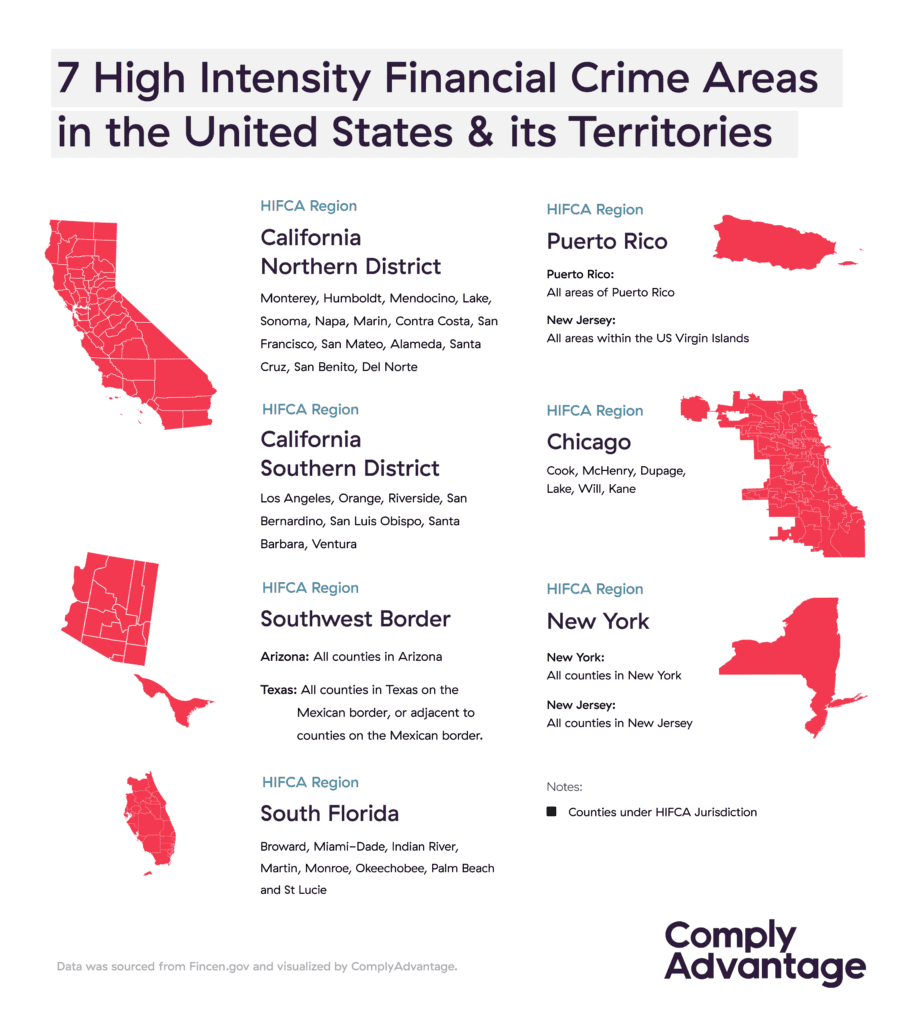AML Tools for HIFCA
Ensure your organization is protected with our AML Screening and Monitoring solutions.
Get Started NowIn the United States, geographic locations that present a particularly high risk of money laundering and financial crime may be designated high-risk money laundering and related financial crime areas, also referred to as high-intensity financial crime areas (HIFCA). Intended to help law enforcement agencies at every level of authority combat money laundering and other financial crimes, HIFCA programs are also relevant to the AML/CFT efforts of financial institutions that may use them to inform their risk assessments and better contribute to the fight against money laundering.
Under FATF Recommendations, to address the global threat of money laundering, countries should ensure that their financial institutions implement risk-based AML compliance solutions. Accordingly, US money laundering legislation specifically requires financial institutions to take geographical risk factors into account when implementing their anti-money laundering programs. Practically, this means that banks, financial institutions and other obligated entities should treat HIFCAs as an important compliance consideration.
The HIFCA designation was conceived in the US’ Money Laundering and Financial Crimes Strategy Act of 1998 and came into effect a year later with the National Money Laundering Strategy for 1999. The legislation defined HIFCAs as areas that present a substantial risk of money laundering and, pursuant to section 5341(b) of the Strategy Act, brought them into the scope of a national initiative to address the criminal activity.
In practice, the HIFCA program serves to concentrate US law enforcement efforts on geographic zones and locations that experience high levels of money laundering activity (and other types of financial crime). The scope of the HIFCA program takes in federal, state, and local law enforcement agencies in locations across the United States and its territories. Each HIFCA-designated location is assigned a money laundering action team that coordinates the combined law enforcement efforts: the action team is made up of individuals from federal, state, and local authorities, including prosecutors and representatives of regulatory organizations.
There are currently 7 HIFCA regions that cover the United States, the US Virgin Islands, and Puerto Rico. The regional designations take in specific counties or, in some cases, all counties within each state and are defined as follows:
While HIFCAs have clear and practical law enforcement benefits, it is important that financial institutions are able to extract meaningful data from the programs to inform their anti-money laundering compliance process.
However, HIFCA regions are defined broadly, collectively covering around 5.39% of the total US population, which amounts to over 16.5 million people. Taken at face value, regional HIFCA designations may be overly inclusive and give the inaccurate impression that the majority of a financial institution’s customers present a high risk of money laundering. For example, while all counties in New York are part of a HIFCA program, it is unlikely that all customers within the state present the same level of money laundering risk.
Given that broad scope, banks and financial institutions must consider how to refine HIFCA risk data to enhance their AML response. Firms may, for example, seek to use peripheral data to interpret HIFCA designations: HIFCA may be cross-referenced with the information from corresponding High Intensity Drug Trafficking Area (HIDTA) programs to identify more specific macro-indicators of AML risk. Similarly, firms may seek to examine the geographic characteristics of the Suspicious Activity Reports (SAR) that they file alongside HIFCA (and HIDTA) data to develop a more localized picture of risk within a given region.
Despite the broad inclusivity of the HIFCA designation, firms may be able to identify high risk transactions by monitoring for certain specific red flag characteristics that indicate money laundering. These include:
In order to capture the money laundering risk that HIFCAs present, firms should implement AML/CFT programs with the following measures and controls:
Automated smart technology is also specifically advantageous for refining and analyzing the unstructured risk data that HIFCAs present. Firms may integrate AI and machine learning tools to process and categorize raw data from HIFCAs – and then apply that data to their AML response in a targeted manner to optimize compliance performance and remediate suspicious activity more effectively.
Ensure your organization is protected with our AML Screening and Monitoring solutions.
Get Started NowOriginally published 30 March 2021, updated 15 April 2024
Disclaimer: This is for general information only. The information presented does not constitute legal advice. ComplyAdvantage accepts no responsibility for any information contained herein and disclaims and excludes any liability in respect of the contents or for action taken based on this information.
Copyright © 2024 IVXS UK Limited (trading as ComplyAdvantage).